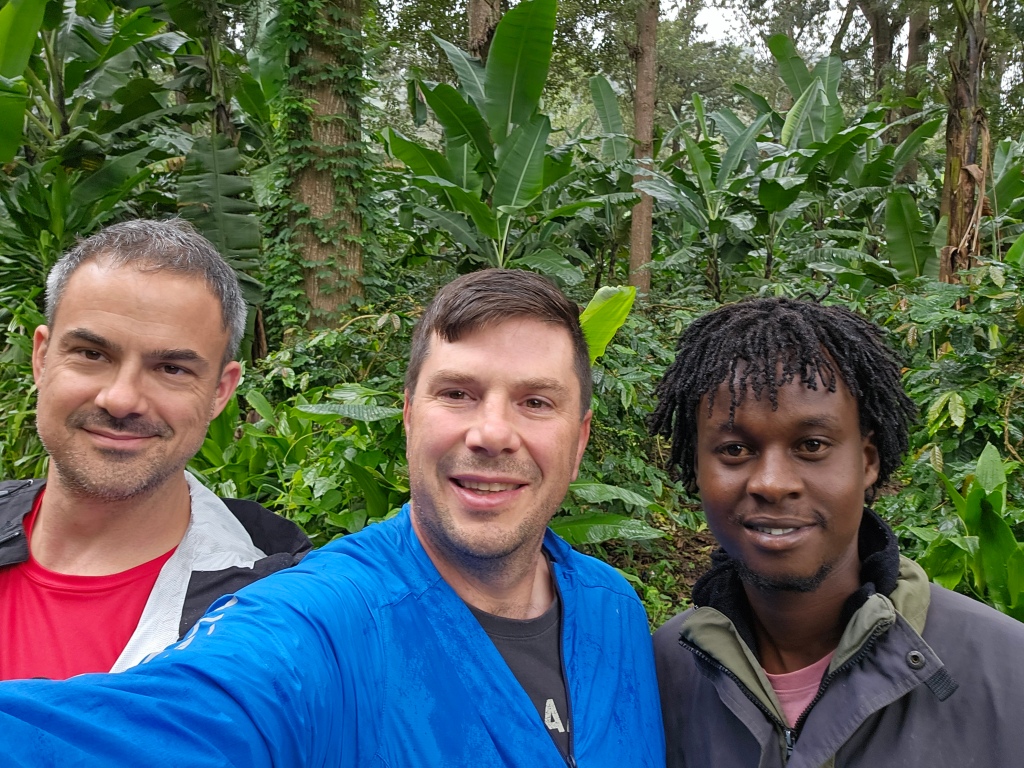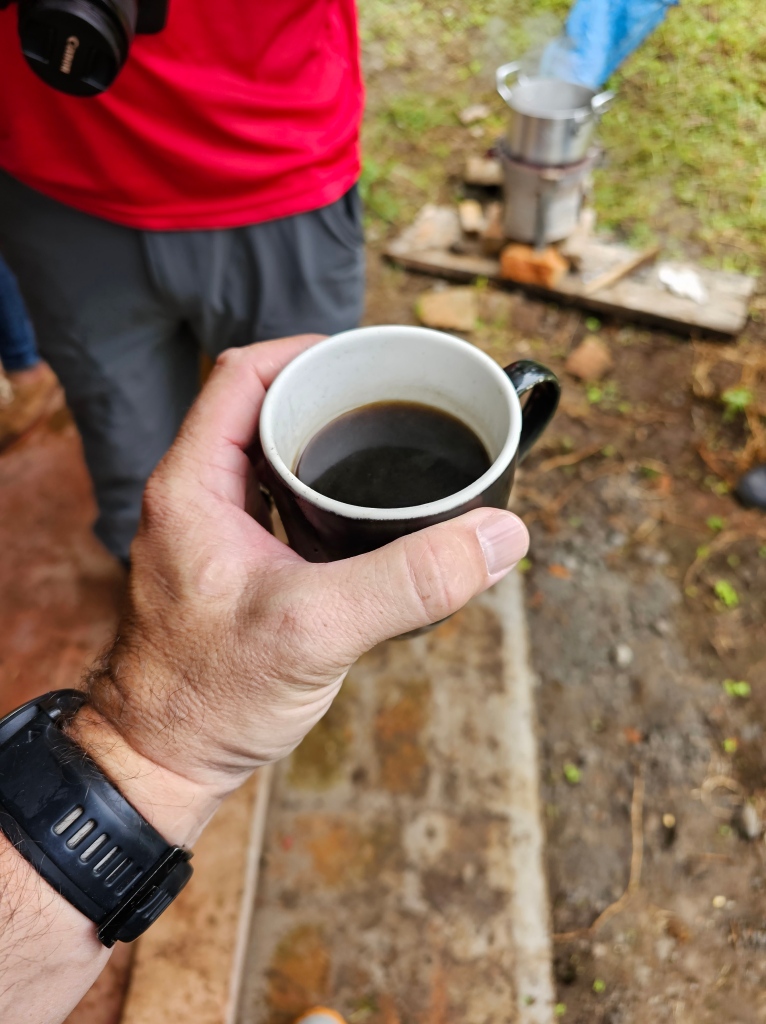
I woke up at 8am after a rough night’s sleep, awake for at least an hour around 3:30am, full of worries and nostalgia. Eight seemed a bit too early so I reset my watch’s alarm for 8:15, but either I failed to do so correctly or I slept through it, waking abruptly at 9 when my brother flipped on the room’s overhead lights. I was in the middle of a pleasant dream at the time, so my mood improved significantly despite the abrupt wakeup. We both dressed in a rush and hurried over to the hotel’s restaurant for breakfast, which was ending soon.
There was a good spread to choose from, and I grabbed two slices of pineapple, a peach yogurt, some dried fruit, and a cup of coffee. A chef was on hand to make us small custom omelettes which we enjoyed on the covered patio. We were amused to get a clipboard with a survey on it as we finished eating — did they confuse us for a party that’d been here for more than a few hours?
After breakfast, we stopped by the front desk to arrange a “Coffee Tour”; the concierge called around for a few minutes and we were quickly set up with a driver leaving soon after. The tour itself was just $30 apiece (including lunch), but the car and driver would cost $150. At first, this seemed a bit steep, until I realized that this wasn’t going to be a simple taxi ride– we were going in a giant Land Rover and our driver was going to be staying with us for several hours. The front desk staff considered our light shirts and suggested that we would be too cold if we didn’t wear warmer clothes, but we ignored their advice upon noticing that both were bundled up in fleece jackets despite what seemed to us to be a perfectly nice ambient temperature.
We headed back to our room for quick showers, then met our driver and drove west toward the city of Arusha.
While the drive wasn’t too far, it was slow — the speed limit on the two-lane main road was 50kph, but we rarely moved that fast, with frequent slowdowns behind trucks, motorbikes, and other slow-moving traffic. Our driver wasn’t very talkative, so we instead mostly looked out the window and pondered little mysteries, like why did so many of the roadside signs have red Xs across them?

We drove by farms (most growing sunflowers), houses, small markets, and numerous parking lots filled with a half dozen or more motorcycles with riders sitting atop chatting amongst each other. Based on the number of motorcycles we saw on the road with two or more riders, we decided these guys must be acting as single-person taxi services. Some of the loads were almost comical– one motorcycle had three riders, two on the front, and a third perched atop three enormous (50+ pound) bags of rice that were draped over the tail.
After a ride of almost half an hour, we turned off on a side street and met our guide on his motorcycle, disembarking the Land Rover to proceed on foot. We chatted as we walked down a few side streets, over a rickety wooden bridge, and went to examine some coffee plants whose cherries weren’t yet ready to harvest. There was a light drizzle and the unpaved road was steep in parts– I was glad to be wearing my boots, but wished I’d brought my hiking poles for a slick and uneven downhill portion.
We crossed a rickety bridge over a small stream next to the fields:
And a moment later we arrived at the edge of the coffee plants.
After a brief look and an obligatory selfie in front of the plants with our coffee expert:
…we headed to the “coffee factory.” The factory was not so much a factory as a small fenced compound where a small hut was set up with a table and chairs, with a mortar/pestle and a small wood-fired stove nearby. Apparently this is how they make coffee for their tourist guests and their families, but most of the harvested beans are taken to a true “factory” in the city.
The fresh beans are laid out to dry in the sun for weeks elsewhere inside the compound, but we skipped ahead to process a few pounds of dried beans. First, you use the mortar and pestle to smoosh the beans so the shell flakes off, then shake/blow the shells away:
After most of the shells blow off, you manually peel any remaining beans. Next, you toast the beans over the fire:
After the beans are toasted, they are tossed again to remove any burned flakes of shells, then go back in the mortar to be ground into a fine powder. As the coffee was ground, our hosts danced and sang silly songs in Swahili, to which we tried to sing along.
The extremely fine powder is then put directly into a pot of boiling water — no filtration is necessary.
A bit of sugar and I was ready to enjoy a cup, about an hour and ten minutes after the preparation began:
As for the coffee itself? It was tasty, especially in the cool afternoon air, but to be completely honest the freshest cup of coffee I’ve ever had didn’t taste much different than an everyday cup. I’m no coffee connoisseur.
After drinking our coffee and packing up two bags to go, we, our driver, guide, and one of their friends headed back to the main road for lunch at a simple restaurant. We had “the brown”, a meat and rice dish said to be traditional when welcoming guests to your home. Given the option of goat or “red meat”, we picked the goat. It was tasty, simple, and not spicy.
After lunch, another half-hour’s drive brought us back to our hotel. After I enjoyed a leisurely Coke and Serengeti Lager in the bar (Jason tried a local soda), we tried out the hotel’s nice-looking pool. Alas, the water was too cold to really enjoy, so we left after 30 minutes and explored the short trail inside the wall of the hotel compound. Back in the room, I decided to wrote in my journal lest I succumb to an untimely nap. The bed was very firm, but comfortable enough that sleep beckoned as I continued to adjust to the 7-hour time change.
Frustratingly, cloud cover all day meant that we still hadn’t caught even a glimpse of Kilimanjaro. We were both excited for the next day’s mini safari — beyond the animals, surely we’d finally get our first look at our destination!
如有侵权请联系:admin#unsafe.sh











